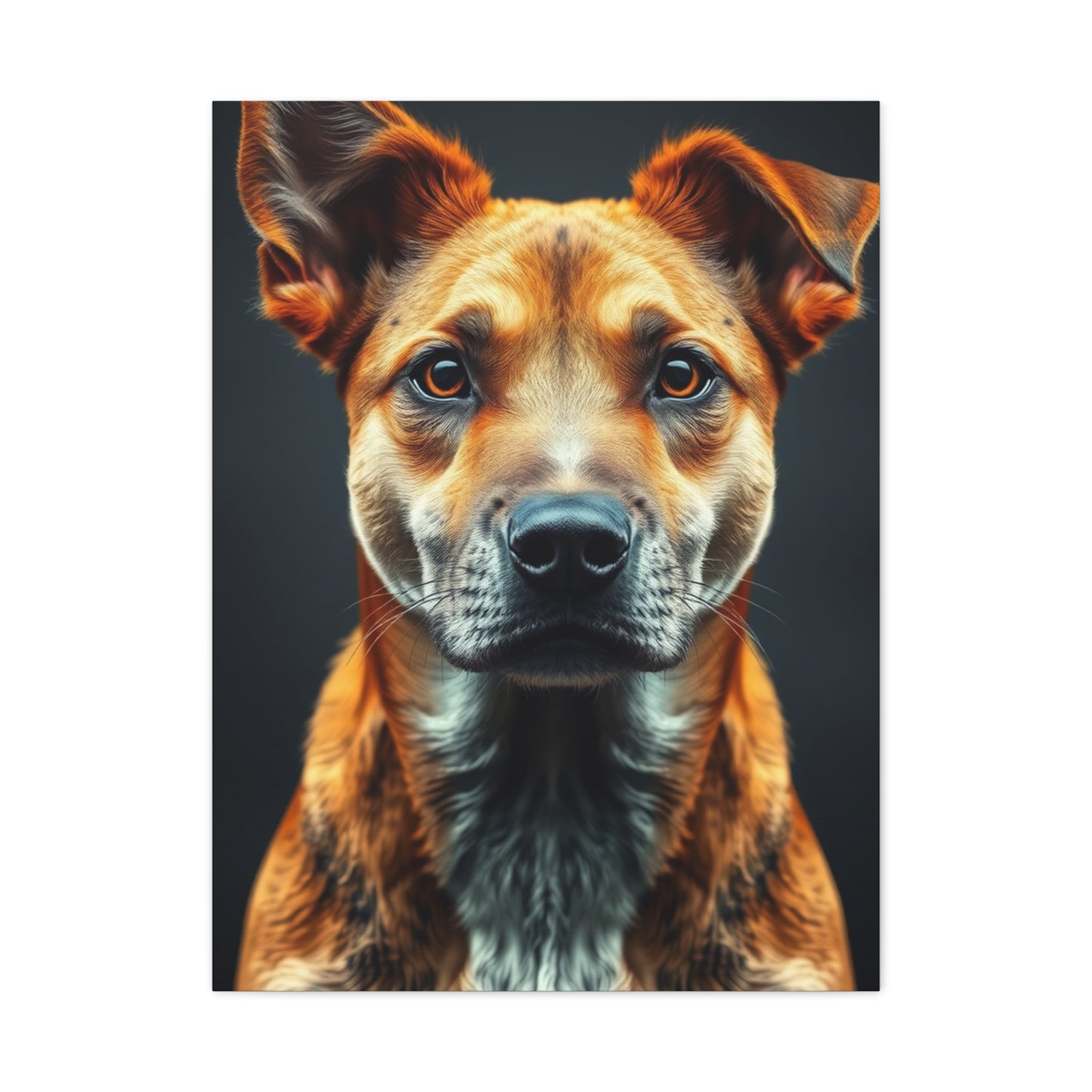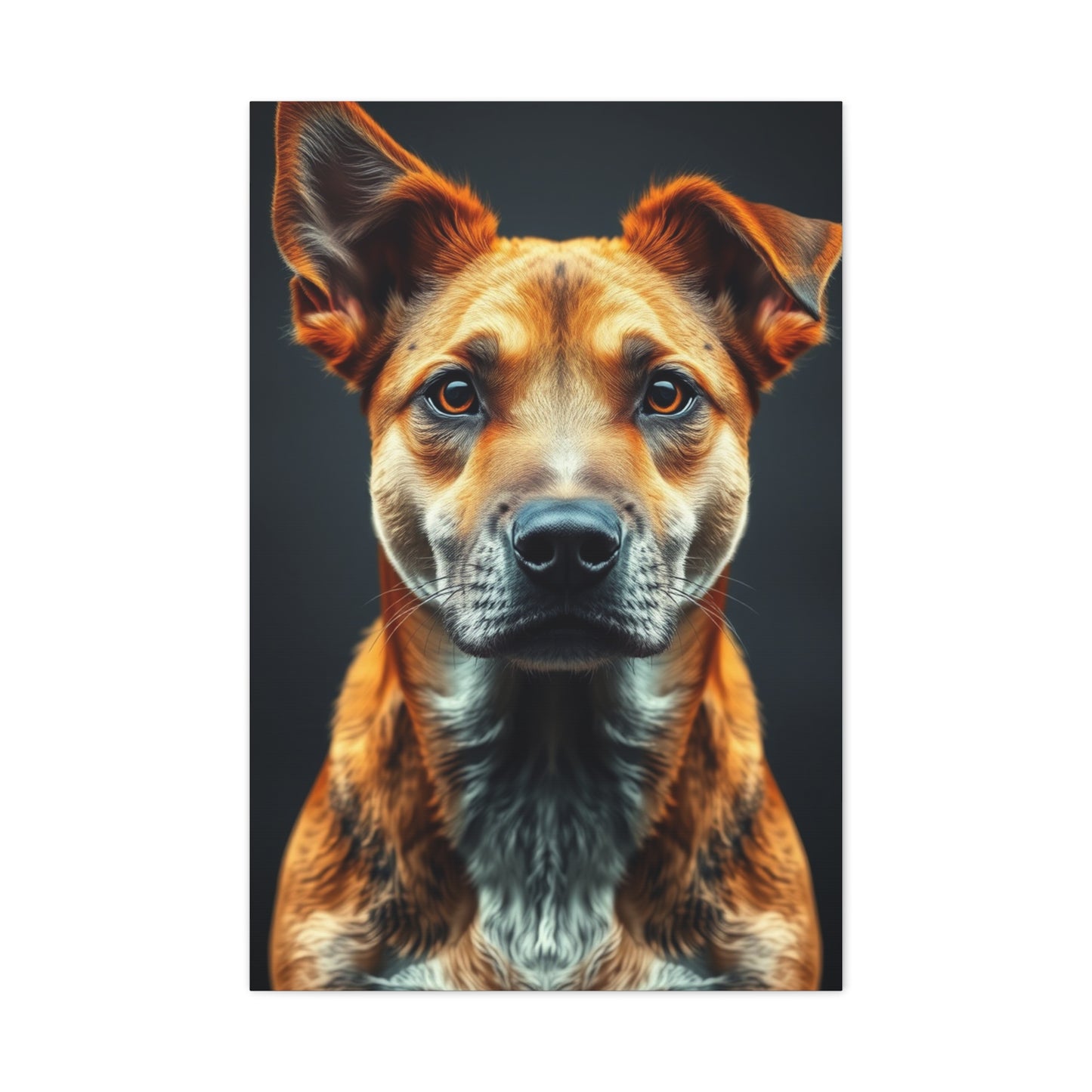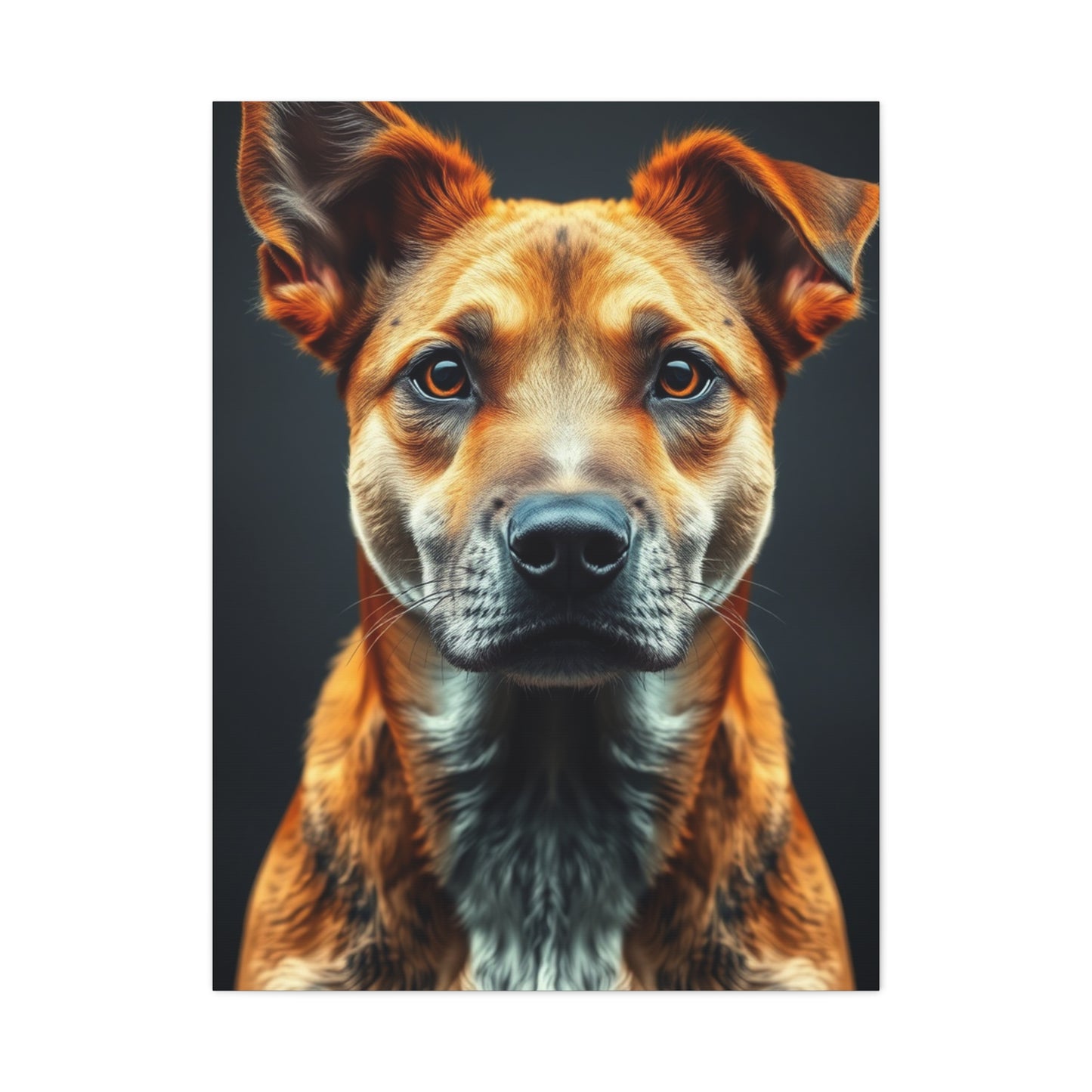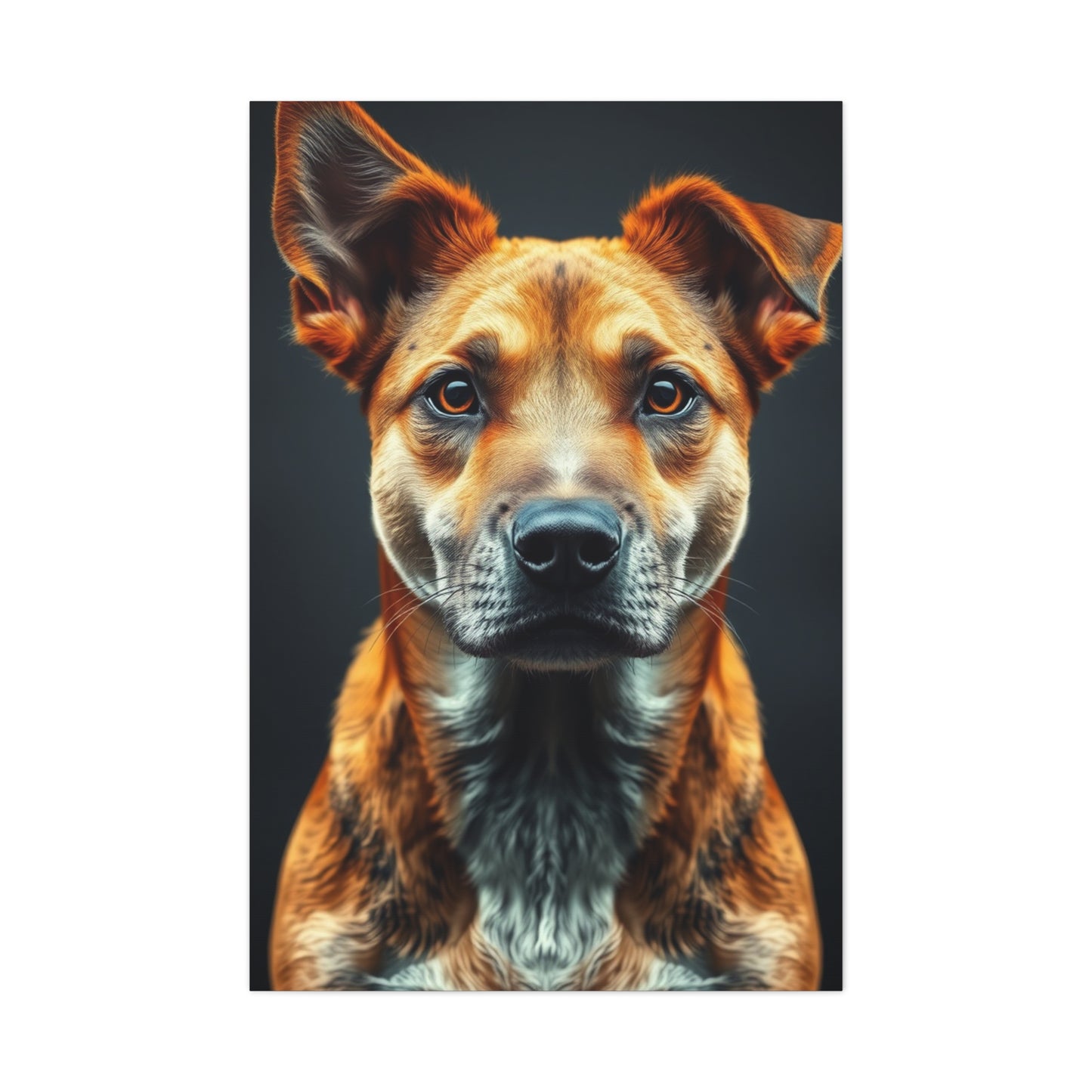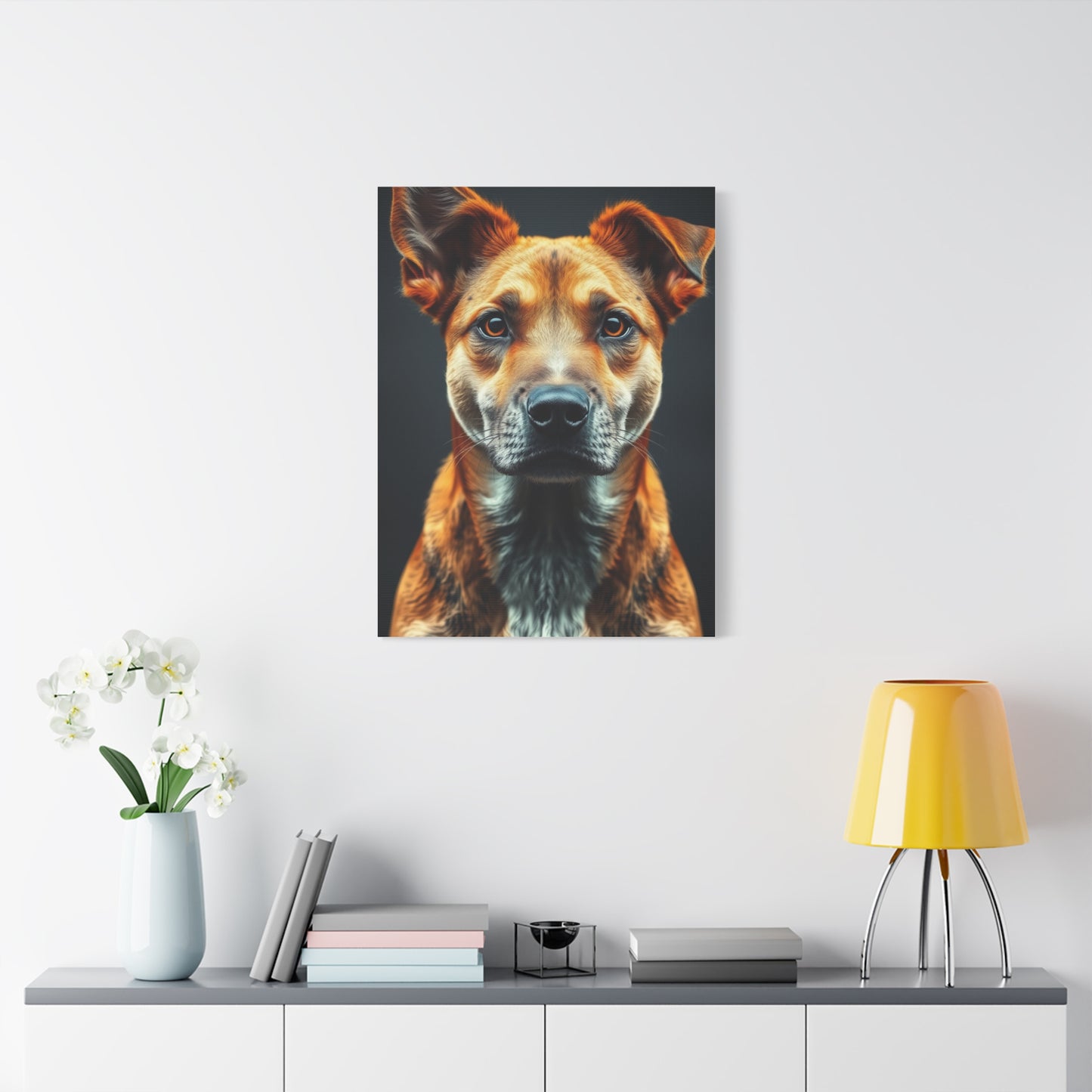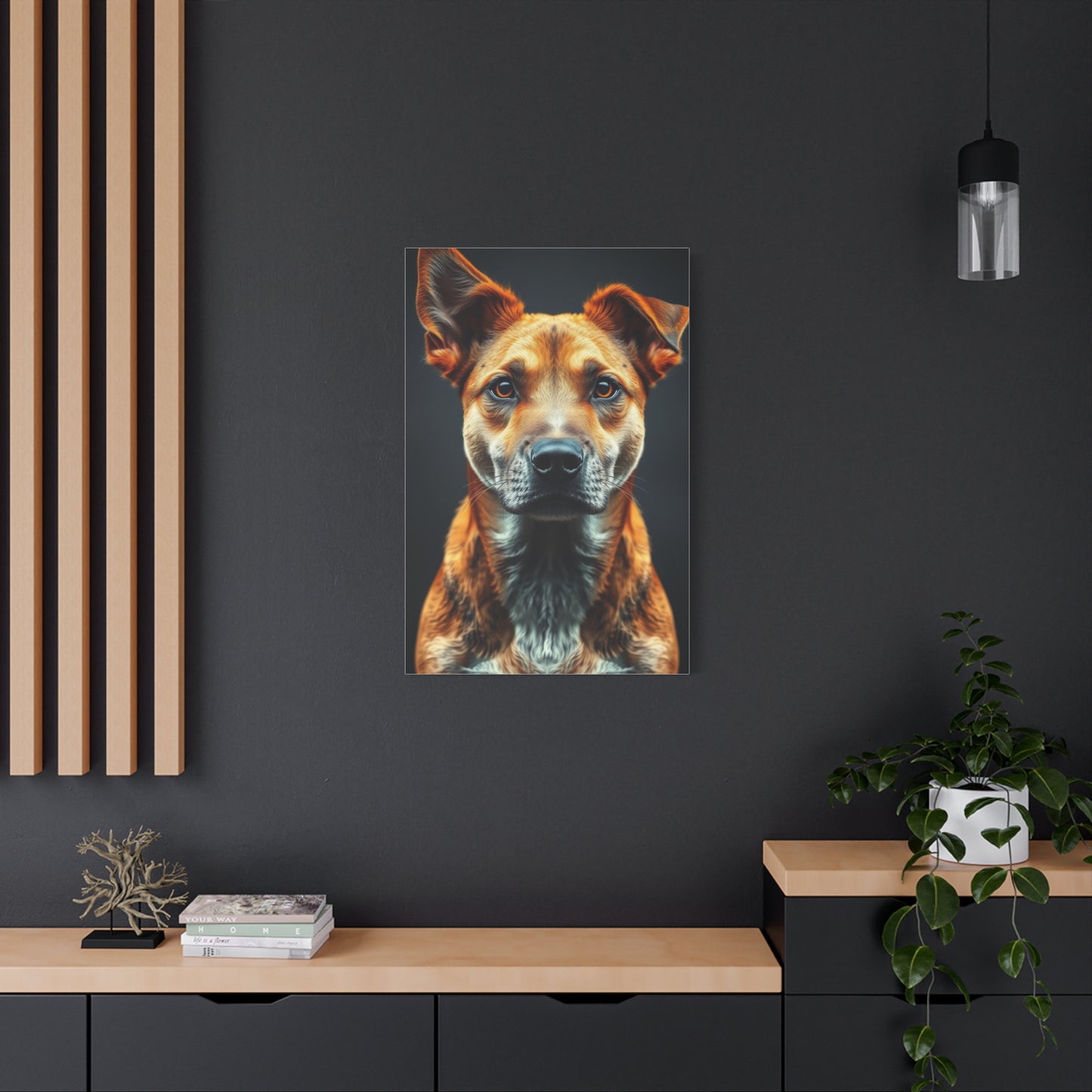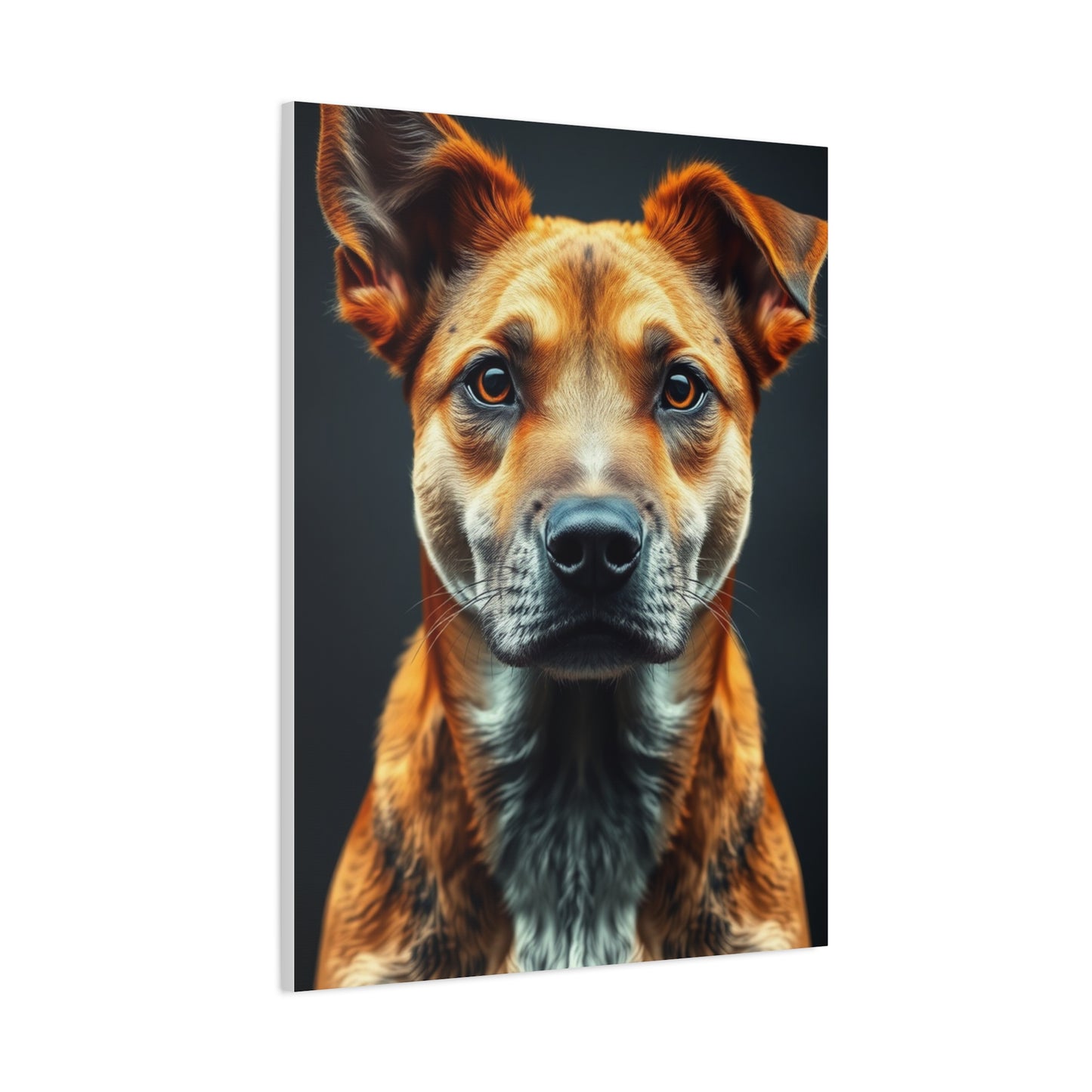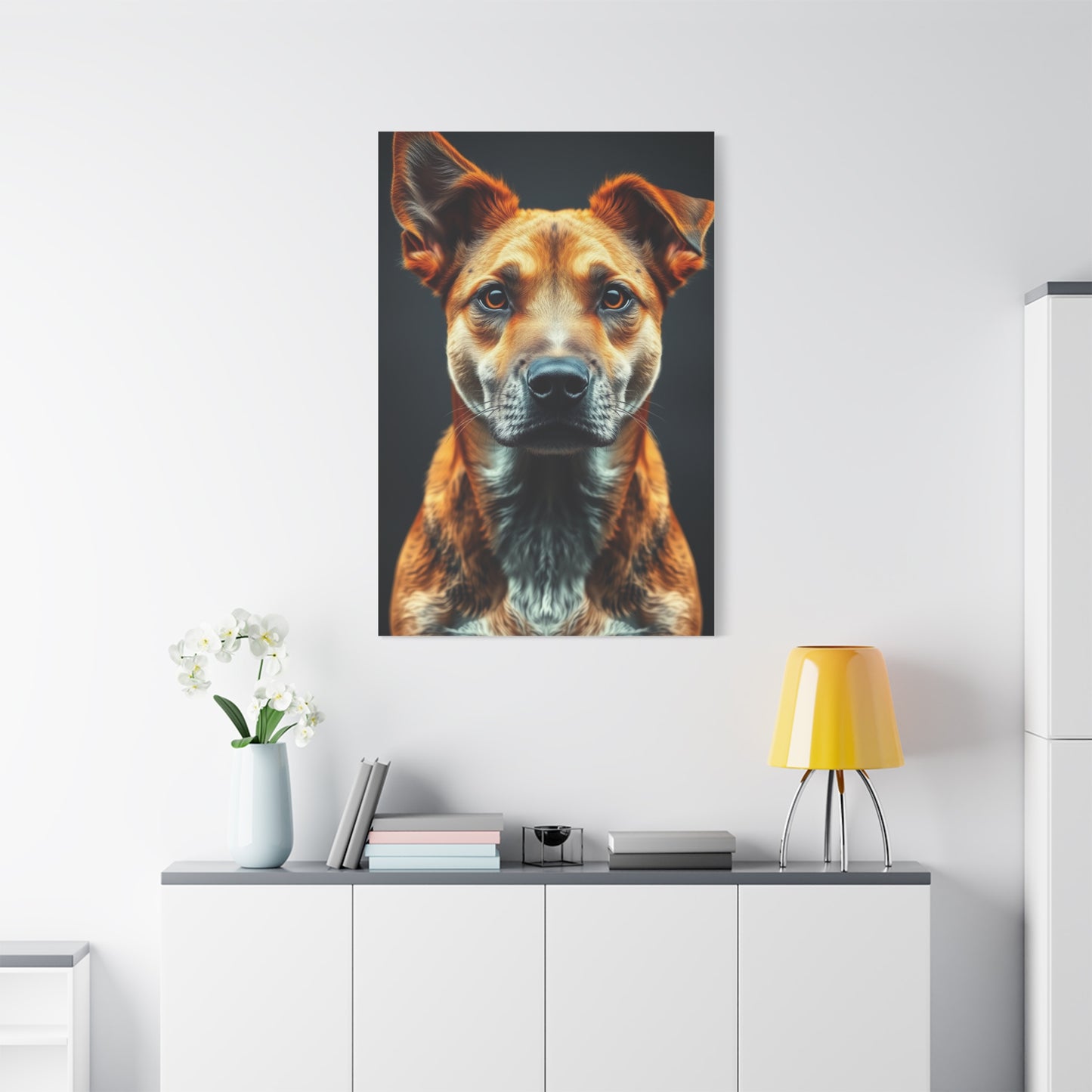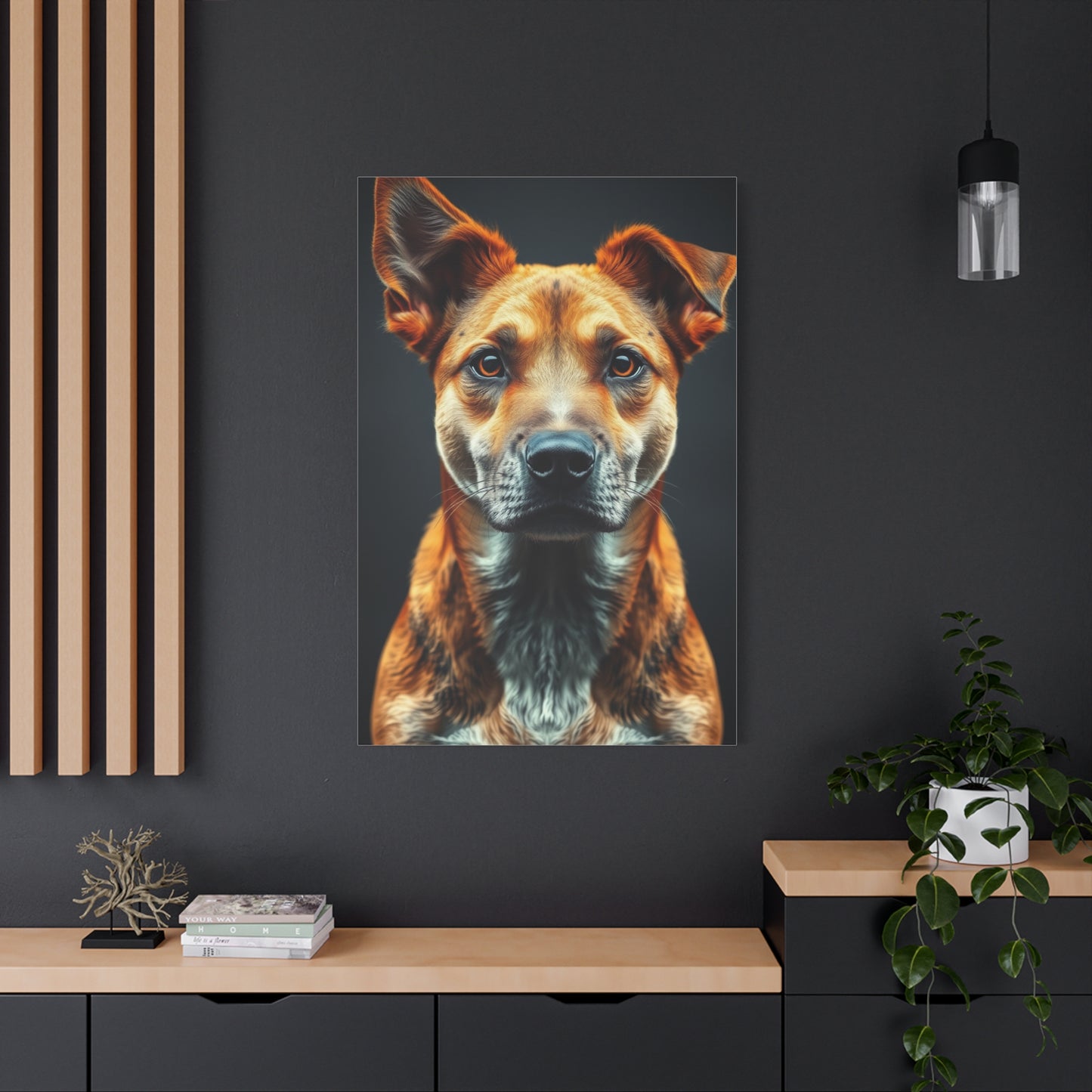The Ultimate Guide to Canine Elegance Portraiture Wall Art: Transforming Your Space with Dog Art
The world of interior decoration has witnessed a remarkable transformation in recent years, with pet-inspired artwork emerging as one of the most sought-after design elements. Among these creative expressions, canine elegance portraiture wall art canvas print stands out as a sophisticated choice for dog lovers and art enthusiasts alike. This unique form of artistic expression combines the timeless beauty of classical portraiture with the endearing charm of our four-legged companions, creating pieces that resonate deeply with viewers on both emotional and aesthetic levels.
When we examine the growing popularity of dog-themed artwork, we discover that it transcends simple pet appreciation. These carefully crafted pieces represent a celebration of the human-animal bond, capturing the nobility, character, and personality of dogs in ways that photographs alone cannot achieve. The canvas print medium offers exceptional versatility, allowing artists to experiment with various styles, from photorealistic renderings to impressionistic interpretations, ensuring that every piece can complement different interior design schemes while maintaining its emotional impact.
The sophistication inherent in elegance portraiture elevates these artworks beyond mere pet pictures. Artists employing classical techniques draw inspiration from historical portrait traditions, incorporating elements such as dramatic lighting, rich color palettes, and carefully considered compositions that highlight the dignified nature of canine subjects. This approach transforms beloved pets into timeless works of art that command attention and admiration, making them perfect focal points for living rooms, home offices, or any space requiring a touch of refined personality.
The Artistic Heritage Behind Canine Portrait Wall Decorations
Throughout history, dogs have held significant places in artistic traditions across numerous cultures and time periods. From ancient Egyptian murals depicting hunting hounds to Victorian-era oil paintings showcasing prized breeds, the representation of dogs in art reflects their importance in human society. Contemporary canine elegance portraiture wall art canvas print continues this rich tradition, adapting classical techniques to modern sensibilities and printing technologies.
The Renaissance period established many conventions still used in modern portraiture, including the three-quarter pose, careful attention to texture and detail, and the use of symbolic elements to convey character and status. Artists creating elegant dog portraits today often draw upon these established principles, applying them to capture the unique qualities of different breeds and individual dogs. This historical connection adds depth and cultural significance to contemporary pieces, making them more than simple decorative items.
European hunting scenes and aristocratic portraits frequently featured beloved dogs, recognizing them as valued companions worthy of artistic immortalization. This tradition of honoring dogs through art has evolved but never diminished, with modern canvas prints offering accessibility that oil paintings could never provide. Today's printing technologies allow for remarkable color accuracy and detail reproduction, ensuring that the artistic vision translates perfectly from digital file to finished canvas, maintaining the integrity of the original artwork while making it available to broader audiences.
Exploring Different Styles of Dog Portraiture Canvas Artwork
The diversity of artistic styles available in canine elegance portraiture wall art canvas print ensures that collectors can find pieces perfectly suited to their personal tastes and interior design preferences. Classical realism remains a perennial favorite, with artists meticulously rendering every fur texture, whisker, and gleam in the eye to create lifelike representations that seem ready to step off the canvas. These pieces appeal to traditionalists who appreciate technical skill and the timeless quality of realistic artwork.
Contemporary approaches offer exciting alternatives for those seeking more modern aesthetics. Abstract interpretations use bold colors, geometric shapes, and expressive brushwork to capture the essence and energy of dogs rather than their literal appearance. These pieces work wonderfully in minimalist or modern interiors, providing visual interest without overwhelming the space. The beauty of abstraction lies in its ability to evoke emotion and personality through suggestion rather than detailed representation.
Impressionistic dog portraits strike a balance between realism and artistic interpretation, using visible brushstrokes and emphasis on light and color to create atmospheric, emotionally resonant pieces. This style particularly suits dogs with flowing coats or those photographed in natural settings, where the interplay of light and movement creates dynamic visual interest. The slightly softer focus of impressionism can also lend a dreamlike quality to portraits, emphasizing the emotional connection between viewer and subject.
Pop art influences have also made their way into dog portraiture, with artists employing bright, saturated colors and graphic elements reminiscent of famous works by contemporary masters. These playful, energetic pieces appeal to collectors with vibrant, eclectic tastes, adding personality and conversation-starting appeal to any room. The bold nature of pop art styling makes these portraits particularly effective in modern spaces with clean lines and neutral backgrounds that allow the artwork to take center stage.
Selecting the Perfect Breed Representation for Your Canvas Print
Different dog breeds possess distinct visual characteristics that lend themselves to various artistic treatments. Understanding how breed characteristics translate to canvas artwork helps collectors make informed decisions when selecting pieces for their homes. Long-coated breeds like Afghan Hounds, Golden Retrievers, and Rough Collies offer artists opportunities to showcase their skill in rendering texture and movement, with flowing fur creating visual dynamism and elegance.
Breeds with distinctive facial features, such as Bulldogs, Pugs, and Boston Terriers, benefit from close-up portrait compositions that emphasize their unique characteristics and expressive faces. These breeds often possess naturally comedic or dignified expressions that translate beautifully to canvas, creating pieces with strong personality and immediate visual impact. The wrinkles, folds, and distinctive shapes characteristic of these breeds provide rich textural interest that skilled artists can exploit for dramatic effect.
Working and sporting breeds like German Shepherds, Labrador Retrievers, and Border Collies are frequently portrayed in action poses or alert stances that capture their intelligence and athleticism. These dynamic compositions work particularly well in home offices or studies, where they can inspire feelings of loyalty, diligence, and focused energy. The muscular build and confident bearing of these breeds lend themselves to powerful compositions that command attention.
Toy and companion breeds including Pomeranians, Yorkshire Terriers, and Cavalier King Charles Spaniels are often portrayed in more intimate, refined settings that emphasize their roles as beloved companions. These portraits frequently incorporate soft lighting and luxurious backgrounds, creating artwork that feels cozy and personal. The delicate features of smaller breeds allow for intricate detail work that rewards close viewing, making these pieces perfect for bedrooms or personal spaces.
Creating Gallery Wall Arrangements with Multiple Dog Portraits
Arranging multiple pieces of canine elegance portraiture wall art canvas print in cohesive gallery wall displays allows collectors to showcase diverse representations while creating unified visual statements. Symmetrical arrangements featuring identical or similarly sized frames create formal, orderly presentations that work well in traditional interiors. These arrangements might include matching portraits of multiple family pets or a series depicting different breeds in consistent artistic styles.
Asymmetrical gallery walls offer more contemporary, dynamic appeal, mixing various sizes and orientations to create visually interesting compositions. The key to successful asymmetrical arrangements lies in balancing visual weight across the display, ensuring that larger, darker, or more colorful pieces are distributed in ways that feel intentional rather than haphazard. Planning layouts on paper or using temporary mounting solutions helps achieve desired results before making permanent commitments.
Thematic consistency helps unify gallery wall displays featuring multiple artworks. This might involve selecting pieces that share color palettes, artistic styles, or subject matter approaches. For example, a collection of portraits showing dogs in similar regal poses or all rendered in black and white creates coherent visual narratives even when depicting different breeds or individual animals. Consistent framing or mounting styles also contribute to unified appearances.
Spacing between individual pieces in gallery wall arrangements affects overall impact and readability. Generally, maintaining consistent spacing of two to three inches between frames creates cohesive groupings without pieces appearing disconnected or cramped. However, intentionally varied spacing can create rhythm and movement within displays, drawing the eye through the arrangement in specific patterns. The overall shape of the gallery wall arrangement should complement the architectural features of the wall and surrounding furniture.
Customization Options for Personalized Dog Portrait Canvas Prints
The growing availability of custom canine elegance portraiture wall art canvas print services allows pet owners to commission unique pieces featuring their own beloved companions. Professional pet portrait artists work from photographs to create personalized artworks that capture individual dogs' unique characteristics and personalities. This customization process typically involves selecting artistic style, color palette, background elements, and canvas size to ensure the finished piece meets specific preferences and design requirements.
Photograph selection significantly impacts the quality of custom portrait outcomes. High-resolution images with good lighting and clear focus on the dog's face yield the best results. Multiple reference photos showing different angles and expressions provide artists with comprehensive understanding of the subject's appearance and character. Many professional artists provide detailed guidance on photograph requirements to ensure clients submit suitable reference materials.
Style consultations help align client visions with artistic execution. Discussing preferences regarding realism versus artistic interpretation, color treatment, and background elements ensures that finished pieces meet expectations. Some artists offer preliminary sketches or digital mockups, allowing clients to request adjustments before final production begins. This collaborative approach produces truly personalized artworks that reflect both the subject's nature and the owner's aesthetic preferences.
Background and setting choices in custom portraits offer opportunities to incorporate meaningful elements or create specific moods. Some clients prefer simple, neutral backgrounds that focus attention entirely on the dog, while others request environmental settings that reflect their pets' favorite activities or locations. Period costume elements can transform ordinary pet portraits into whimsical historical or fantasy-themed pieces, adding humor and personality to the finished artwork.
Placement Strategies for Different Room Types and Functions
Strategic placement of canine elegance portraiture wall art canvas print maximizes both visual impact and thematic appropriateness across various living spaces. Living rooms offer prime opportunities for displaying substantial, impressive pieces that serve as conversation starters and reflect homeowners' personalities. Above seating arrangements, mantels, or on feature walls, dog portraits contribute warmth and character to these social spaces where families gather and guests are entertained.
Bedroom displays benefit from more personal, intimate artwork that creates comforting, restful atmospheres. Portraits featuring beloved family pets in softer color palettes and gentler compositions enhance the private, sanctuary-like quality of sleeping spaces. Positioning artwork at appropriate viewing heights for reclining positions ensures comfortable enjoyment from bed, with lighting designed to illuminate pieces without creating disruptive glare.
Home offices and studies accommodate dog portraits that inspire focus, loyalty, and dedication—qualities many working breeds exemplify. These spaces allow for more eclectic or bold artistic choices, as they typically serve individual occupants rather than diverse family members or guests. The presence of pet portraits in workspaces can reduce stress and provide emotional support during challenging tasks, making them functional as well as decorative elements.
Entryways and hallways present opportunities for creating impactful first impressions with carefully selected canine artwork. These transitional spaces often feature narrower wall areas well-suited to vertical portrait orientations or gallery wall arrangements of smaller pieces. The artwork visible upon entry sets the tone for the entire home, communicating personality, values, and aesthetic preferences to visitors.
Integrating Dog Portrait Canvas Art with Various Design Styles
Successfully incorporating canine elegance portraiture wall art canvas print into diverse interior design schemes requires understanding how different aesthetic approaches can be harmonized. Traditional and classical interiors naturally accommodate realistic pet portraits with rich color palettes and formal compositions. These settings benefit from artwork that echoes the refined qualities of antique furnishings and architectural details, creating cohesive environments where every element contributes to an overall impression of timeless elegance.
Contemporary and modern spaces embrace clean lines, minimalist aesthetics, and bold statements, requiring dog portraits that complement rather than conflict with these principles. Monochromatic prints, abstract interpretations, or pieces with significant negative space work well in these environments. The key lies in selecting artwork that provides visual interest and personality without introducing complexity that fights against the intentional simplicity of modern design.
Rustic and farmhouse styles welcome dog portraits that emphasize natural settings, earthy color palettes, and casual, approachable compositions. These interiors benefit from artwork depicting outdoor scenes, working breeds, or pieces with visible brushwork and textural qualities that echo the organic, handcrafted feel of farmhouse decor. Distressed or natural wood frames complement these settings, creating unified presentations that feel collected and authentic.
Eclectic and bohemian spaces offer the greatest freedom for creative artwork selection and display. These interiors celebrate mixing diverse styles, colors, and eras, allowing dog portraits to coexist with varied artwork types and decorative objects. The collected, personal nature of eclectic design means that virtually any style of canine portraiture can work, provided it reflects the homeowner's genuine interests and contributes to the space's unique character.
The Emotional and Psychological Benefits of Pet Artwork
Displaying canine elegance portraiture wall art canvas print offers significant emotional and psychological benefits beyond mere decoration. Research in environmental psychology demonstrates that personalized spaces featuring meaningful imagery contribute to overall wellbeing and life satisfaction. For dog lovers, viewing portraits of beloved pets or favorite breeds provides daily doses of positive emotion, reducing stress and increasing feelings of connection and contentment.
The presence of pet imagery in living spaces reinforces human-animal bonds even when actual pets are absent. For individuals whose work schedules limit time with their dogs, having portraits visible throughout the home maintains that connection, providing comfort and reducing feelings of separation. These visual reminders of beloved companions can ease anxiety and provide emotional anchoring during challenging times.
Memorial portraits serve particularly meaningful purposes, helping grieving pet owners maintain connections with departed companions while celebrating their lives and legacies. These pieces transform loss into lasting tribute, providing focal points for positive memories and ongoing emotional bonds. The process of selecting or commissioning memorial artwork can itself contribute to healthy grieving, offering constructive ways to honor and remember beloved animals.
For families with children, dog portraits contribute to environments that value empathy, responsibility, and respect for animals. Growing up surrounded by artwork that depicts animals as worthy subjects of artistic attention reinforces positive attitudes toward animal welfare and the importance of the human-animal bond. These subtle environmental influences shape developing values and perspectives in lasting ways.
Commissioning Processes and Working with Pet Portrait Artists
Engaging professional artists to create custom canine elegance portraiture wall art canvas print involves specific processes and considerations that ensure successful outcomes. Initial consultations establish artistic direction, discussing style preferences, intended display locations, and budget parameters. These conversations help artists assess whether they can meet client expectations and allow clients to evaluate whether artists' styles align with their visions. Reviewing portfolios and previous commissioned works provides insight into artists' capabilities and approaches.
Pricing structures for commissioned pet portraits vary considerably based on artist reputation, artwork size, complexity, and medium. Some artists charge flat rates for standard sizes and formats, while others calculate fees based on time estimates for particular projects. Understanding what's included in quoted prices—preliminary sketches, revision rounds, framing, shipping—prevents misunderstandings and allows accurate budget planning. Requesting detailed written agreements protects both parties and establishes clear expectations.
Timeline expectations should be established upfront, considering artists' current workloads and the complexity of commissioned pieces. Rush commissions may incur premium charges, while standard timelines typically range from several weeks to several months depending on the artist and project scope. Building buffer time into plans prevents disappointment and allows for unexpected delays in the creative process. Regular communication throughout the commission ensures projects proceed smoothly and address any concerns promptly.
Revision policies vary among artists, with some including limited revision rounds in initial quotes while others charge additional fees for changes beyond initial agreements. Clearly understanding these policies before committing prevents conflicts and ensures clients can request reasonable adjustments to achieve desired results. Providing detailed, specific feedback rather than vague criticisms helps artists understand and implement requested changes efficiently.
Gift Ideas and Occasions for Presenting Dog Portrait Canvas Prints
Canine elegance portraiture wall art canvas print makes thoughtful, deeply personal gifts for various occasions throughout the year, celebrating both the recipients and their beloved companions. New pet adoptions provide perfect opportunities for commissioning custom portraits that commemorate the beginning of human-canine relationships. These gifts acknowledge the significance of welcoming dogs into families while providing lasting mementos of puppies or newly adopted adults in their earliest days with new owners. Including adoption dates or names in portrait designs adds personalization that increases sentimental value.
Holiday gift-giving traditions embrace pet portraits as alternatives to generic presents, offering uniqueness and thoughtfulness that demonstrate genuine understanding of recipients' priorities and affections. For dog enthusiasts, few gifts compare to professionally executed portraits of their companions, making these artworks ideal Christmas, Hanukkah, or birthday presents. Advance planning allows adequate time for custom commissions, though curated collections of pre-made breed-specific portraits provide excellent options when time constraints prevent custom work.
Memorial occasions, while somber, benefit from thoughtful gifts that honor departed pets and support grieving friends or family members. Commissioning portraits from photographs of deceased dogs provides meaningful tributes that help preserve memories and celebrate lives lived. These gifts acknowledge the profound grief accompanying pet loss while offering tangible expressions of sympathy and understanding. Selecting artistic styles that emphasize beauty, peace, or dignity helps create pieces that comfort rather than intensify sadness.
Wedding and housewarming gifts for dog-loving couples gain special significance when incorporating their pets into the artwork or selecting breed-specific portraits that reflect their current or future companions. These gifts personalize new homes and celebrate the complete family units that include four-legged members. For couples whose dogs played roles in their relationships or engagements, custom portraits commemorating these special animals become treasured possessions that mark important life transitions.
Color Coordination Strategies for Integrating Art with Home Decor
Successfully integrating canine elegance portraiture wall art canvas print into existing interior design schemes requires thoughtful consideration of color relationships between artwork and surrounding elements. The dominant colors in the portrait should either complement or provide intentional contrast with wall colors, furniture upholstery, and accent pieces to create cohesive or dynamically interesting spaces. Monochromatic schemes, where artwork and decor share similar color families, create harmonious, restful environments particularly suited to bedrooms and quiet retreats. Variations in tone and saturation within the chosen color family provide visual interest without disrupting overall unity.
Analogous color schemes use colors adjacent on the color wheel, such as blues, greens, and teals, creating naturally harmonious relationships that feel peaceful and coordinated. Dog portraits featuring backgrounds or color treatments in analogous relationships with room colors integrate seamlessly while maintaining distinct presence. This approach works well for collectors wanting artwork to enhance rather than dominate spaces, allowing other design elements equal visual weight.
Complementary color schemes employ opposite color wheel positions to create vibrant, energetic contrasts that draw attention and create focal points. A portrait featuring warm orange and red tones displayed against cool blue-gray walls creates visual excitement that enlivens neutral spaces. This bold approach suits contemporary interiors and collectors comfortable with strong visual statements. Balancing complementary contrasts through careful attention to color proportions and intensities prevents overwhelming effects while maintaining dynamic interest.
Neutral-dominant color schemes rely on whites, grays, beiges, and blacks as primary colors, allowing artwork to introduce controlled color accents. This approach provides flexibility for rotating artwork or changing accent colors seasonally without requiring major design overhauls. Dog portraits featuring subtle color in primarily neutral compositions work beautifully in these schemes, adding life and interest without disrupting careful balance. The strategy particularly suits minimalist and Scandinavian-inspired interiors where restraint and simplicity guide design decisions.
Insurance and Valuation Considerations for Art Collections
Protecting investments in canine elegance portraiture wall art canvas print through appropriate insurance coverage safeguards against loss, damage, or theft while ensuring compensation sufficient for replacement or restoration. Homeowners and renters insurance policies typically include limited coverage for artwork, but valuable pieces may exceed these standard limits, requiring scheduled personal property endorsements or separate fine art policies. Documenting artwork through professional appraisals establishes values for insurance purposes and provides credible bases for claims settlement.
Professional appraisals should be updated periodically to reflect market changes and ensure coverage keeps pace with appreciation in artwork values. Appraisers specializing in contemporary art and prints understand relevant market factors and can provide defensible valuations acceptable to insurance companies. Documentation should include detailed descriptions, measurements, condition reports, photographs, and provenance information. Maintaining records of purchase prices, certificates of authenticity, and any restoration or conservation work supports appraisal accuracy and claims processing.
Replacement cost versus actual cash value coverage options affect premium costs and claim settlements differently. Replacement cost policies pay to replace lost or destroyed artwork with comparable pieces at current market prices, without depreciation deductions. Actual cash value policies factor in depreciation, potentially providing insufficient funds for replacing artwork that has appreciated. For serious collectors building valuable collections, replacement cost coverage better protects investments despite higher premium costs.
Security measures including alarm systems, climate control, and secure mounting hardware may qualify collectors for insurance premium discounts while protecting artwork from theft, environmental damage, and accidental falls. Insurance carriers appreciate risk mitigation efforts that reduce claim likelihood, often reflecting this through reduced premiums. Consulting with insurance agents familiar with art collections ensures appropriate coverage types and levels while identifying available discounts and risk reduction strategies.
Online Marketplaces Versus Local Galleries for Purchasing Canvas Prints
The decision between purchasing canine elegance portraiture wall art canvas print through online platforms or local galleries involves tradeoffs affecting price, selection, viewing experience, and support for artists and communities. Online marketplaces offer unprecedented selection, connecting collectors with artists worldwide and providing access to styles and subjects that local markets might not support. The convenience of browsing extensive inventories from home, comparing prices across multiple sellers, and reading customer reviews streamlines shopping while accommodating busy schedules and limited local gallery access.
Price advantages often favor online purchases, as artists selling directly through personal websites or platforms avoid gallery commission structures that typically claim forty to sixty percent of sale prices. These savings may be passed to customers through lower retail prices or retained by artists as compensation more reflective of their work's value. However, online shopping eliminates opportunities to examine artwork in person before purchasing, requiring trust in product descriptions, photographs, and seller reputations. Color accuracy in online images varies depending on photography quality and screen calibration, potentially leading to disappointment when received artwork differs from expectations.
Local galleries provide invaluable opportunities to view artwork under proper lighting conditions, assess canvas quality and printing execution, and compare multiple pieces side by side. Gallery staff offer expertise and guidance unavailable through online shopping, helping collectors consider factors like sizing, framing, and placement. Supporting local galleries strengthens community cultural infrastructure and provides venues where artists can exhibit work, connect with collectors, and build regional followings. The relationships developed through gallery interactions enrich collecting experiences beyond simple commercial transactions.
Hybrid approaches combining online research with local purchasing, or vice versa, leverage advantages of both channels. Discovering artists online then seeking their work through local representatives, or visiting galleries to identify preferred styles then exploring artists' broader portfolios online, creates comprehensive shopping experiences. Many successful artists maintain both online presences and gallery relationships, understanding that different collectors prefer different purchasing experiences and that diverse sales channels maximize market reach.
Shipping and Handling Considerations for Canvas Artwork
Proper packaging and shipping procedures ensure that canine elegance portraiture wall art canvas print arrives safely regardless of distance traveled or shipping method employed. Professional art shippers use rigid corrugated cardboard corners that protect canvas edges from impact damage during transit. These reinforcements prevent crushing forces from deforming stretcher frames or damaging canvas edges where the fabric wraps around frame corners. Additional cardboard sheets placed against canvas faces protect printed surfaces from abrasion or puncture.
Moisture protection through plastic wrapping or waterproof outer packaging prevents damage from rain, humidity, or liquid spills during shipping. While canvas itself resists some moisture, prolonged exposure or direct water contact can damage both canvas and inks. Professional shippers seal packages thoroughly while ensuring that plastic doesn't contact canvas surfaces directly for extended periods, as this can transfer plasticizer chemicals or create conditions promoting mold growth.
Dimensional considerations affect shipping costs and methods, with larger canvas prints requiring freight shipping or specialized art carriers rather than standard parcel services. Understanding dimensional weight pricing, where shipping costs reflect package size as well as actual weight, helps collectors anticipate costs and plan budgets accurately. Some online sellers include shipping in listed prices, while others charge separately, affecting price comparisons between sellers.
Insurance during shipping protects against loss or damage, with coverage based on declared values. Underinsuring valuable artwork saves minor premium costs while exposing collectors to significant financial losses should damage occur. Full-value insurance costs more but provides peace of mind and adequate compensation for replacement or restoration. Requiring signature confirmation for valuable shipments prevents theft through porch piracy and ensures that packages reach intended recipients rather than being left unattended.
Artist Spotlights and Emerging Trends in Dog Portraiture
The contemporary canine elegance portraiture wall art canvas print scene includes diverse artists working in varied styles and approaching dog subjects with unique perspectives and techniques. Emerging artists leverage social media platforms to build followings, share works in progress, and connect directly with potential collectors without traditional gallery gatekeepers. This democratization allows talented artists without formal training or connections to establish careers based purely on skill and audience appeal, diversifying the field and introducing fresh voices.
Current trends favor bold, graphic approaches that simplify forms into essential shapes and limited color palettes, creating striking images with immediate visual impact. These contemporary interpretations move away from photorealistic rendering toward more interpretive, design-oriented aesthetics that function equally well as standalone art and as elements within broader decorative schemes. The graphic simplification particularly appeals to younger collectors and those furnishing modern, minimalist spaces where traditional realism might feel stylistically incongruous.
Mixed media approaches combining painted elements with digital manipulation, collage, or photographic elements create layered, textured works that push boundaries between painting, photography, and digital art. These experimental pieces challenge conventional categorizations while producing visually engaging results that reference multiple artistic traditions simultaneously. Collectors interested in contemporary art movements find these hybrid works particularly appealing, as they reflect current artistic conversations about medium, authenticity, and artistic process.
Customization and personalization trends extend beyond simple pet portrait commissions to include elaborate themed portraits placing dogs in historical, fantasy, or celebrity-inspired contexts. These playful, imaginative works transform ordinary pets into Renaissance nobles, superheroes, or pop culture icons, creating humorous, endearing pieces that celebrate both the pets and their owners' creativity. The trend reflects broader cultural embrace of pets as family members worthy of elaborate celebration and artistic treatment once reserved exclusively for humans.
Photography Versus Painted Portraits in Contemporary Practice
The relationship between photography and painting in canine elegance portraiture wall art canvas print production reflects ongoing artistic debates about mechanical versus hand-rendered image creation. Photographic portraits offer unparalleled detail and accuracy, capturing momentary expressions and subtle details that even skilled painters might miss. Modern digital photography and post-processing allow photographers to manipulate images extensively, blurring distinctions between straight photography and artistic interpretation. Fine art dog photography has emerged as its own genre, with specialized photographers creating sophisticated compositions rivaling painted works in artistic merit.
Painted portraits, whether created traditionally or digitally, offer interpretive flexibility that photography cannot match. Artists can idealize, emphasize, or minimize features according to aesthetic goals rather than optical accuracy. This artistic license allows for flattering adjustments, enhanced color drama, and compositional manipulations that create more visually striking results than straight photography typically produces. The visible evidence of artistic hand in brushstrokes or digital painting marks adds value for collectors who appreciate craftsmanship and individual artistic vision.
Hybrid approaches use photographs as references for painted interpretations, combining photography's accuracy with painting's interpretive possibilities. This workflow dominates contemporary custom portrait commissioning, with artists working from client-supplied photographs to create painted renderings. The degree of interpretation varies among artists, from tight, photorealistic painting that closely follows reference photos to loose, impressionistic approaches that extract essence rather than details from photographic sources.
The choice between photographic and painted styles ultimately reflects personal aesthetic preferences and intended uses for finished pieces. Photographic portraits suit collectors valuing accuracy and modern aesthetics, while painted works appeal to those preferring traditional artistic approaches and visible artistic interpretation. Many collectors maintain diverse collections including both approaches, selecting styles based on individual subjects and display contexts rather than adhering rigidly to single preferences.
The Role of Social Media in Promoting Dog Portrait Artists
Social media platforms have revolutionized how artists creating canine elegance portraiture wall art canvas print market their work and connect with potential collectors. Visual platforms particularly suited to artwork promotion allow artists to build engaged followings by regularly sharing finished pieces, work-in-progress shots, and behind-the-scenes content that humanizes their creative processes. The immediate, global reach of social media enables emerging artists to bypass traditional gallery systems, building careers based directly on audience engagement and sales rather than institutional validation.
The algorithmic content distribution characteristic of social media rewards consistent posting and high engagement, pushing artists to maintain active presences and interact regularly with followers. This constant connection between artists and audiences creates communities around individual creators, with loyal followers eagerly anticipating new releases and spreading awareness through shares and recommendations. The direct relationship between artists and collectors fostered through social media can translate into custom commissions and ongoing patronage relationships that sustain artistic careers.
Hashtag strategies help artists reach beyond existing followers to audiences specifically interested in dog art, particular breeds, or interior design applications. Strategic hashtag use connects content with users actively searching for artwork to purchase or admire, driving traffic to artist profiles and websites. Understanding platform-specific best practices and trending topics allows savvy artists to maximize visibility and capitalize on current interests within broader communities.
Paid advertising options on social media platforms enable targeted marketing reaching users based on demographics, interests, and online behaviors. Artists can direct advertisements specifically to dog owners, art collectors, or individuals who have recently engaged with similar content, ensuring marketing budgets reach receptive audiences. The measurable nature of digital advertising provides clear data on campaign effectiveness, allowing artists to refine strategies and maximize return on advertising investments.
Creating Cohesive Multi-Panel Artwork Displays
Multi-panel presentations of canine elegance portraiture wall art canvas print create impactful visual statements through strategic arrangement of related pieces functioning as unified compositions. Diptychs splitting single images across two panels create horizontal or vertical compositions spanning considerable wall space while maintaining unified subjects and narratives. The deliberate separation between panels creates visual interest through negative space and draws attention to the relationship between distinct sections, encouraging viewers to engage with how separated elements combine into coherent wholes.
Triptychs extend this concept across three panels, offering additional compositional possibilities and greater potential scale. Traditional triptych formats feature larger central panels flanked by smaller side panels, creating hierarchical emphasis on central subjects while surrounding elements provide context or complement primary images. Contemporary approaches sometimes employ equal-sized panels arranged horizontally or vertically, creating modular, expandable compositions that can adapt to different wall spaces.
Series presentations featuring multiple separate but thematically related portraits create narrative progressions or comparative studies. A series showing the same dog at different life stages, from puppy through senior years, tells compelling visual stories about growth, aging, and enduring relationships. Breed comparison series displaying multiple breeds in consistent styling and compositions appeal to general dog enthusiasts while showcasing artistic range and creating decorative flexibility through modular arrangements.
Grid arrangements organizing multiple small to medium-sized portraits in neat rows and columns create gallery wall effects with contemporary, organized aesthetics. This presentation style works particularly well for collections featuring multiple family pets or favorite breeds, allowing each subject individual space while contributing to larger unified displays. Consistent sizing and spacing create visual rhythm and orderliness that prevents busy feelings even with numerous individual pieces.
Environmental Factors Affecting Canvas Display Longevity
Understanding environmental conditions that impact canine elegance portraiture wall art canvas print preservation helps collectors protect their investments and maintain artwork quality over decades. Temperature fluctuations cause expansion and contraction in canvas fibers and stretcher frames, potentially leading to sagging canvas, warping frames, or cracking in printed surfaces. Maintaining stable temperatures between sixty-five and seventy-five degrees Fahrenheit minimizes these mechanical stresses, preserving structural integrity and surface quality.
Humidity levels significantly affect organic materials like cotton canvas, with excessive moisture promoting mold growth, mildew, and fiber degradation while insufficient humidity causes brittleness and cracking. Ideal relative humidity ranges between forty and fifty-five percent provide enough moisture to keep materials supple without encouraging biological growth. Dehumidifiers in damp climates and humidifiers in arid regions help maintain appropriate levels, protecting artwork alongside furniture, floors, and other moisture-sensitive household elements.
Air quality considerations include avoiding exposure to smoke, cooking fumes, and industrial pollutants that deposit residues on canvas surfaces or chemically interact with inks and fibers. Kitchens and smoking areas present particular hazards, with airborne particles gradually accumulating on artwork and causing discoloration or damage. Adequate ventilation and air filtration systems reduce these contaminants, benefiting both artwork and occupant health.
Physical protection from accidental contact, especially in high-traffic areas or homes with children and pets, prevents scratches, punctures, and other mechanical damage. Strategic placement away from doorways, hallways, and play areas reduces collision risks. Furniture arrangement creating physical barriers between artwork and traffic patterns provides additional protection. For particularly valuable or vulnerable pieces, acrylic glazing offers transparent physical barriers while maintaining visibility and aesthetic appeal.
Interior Design Movements and Their Relationship to Dog Art
Contemporary interior design movements embrace canine elegance portraiture wall art canvas print in ways reflecting their distinct philosophical approaches and aesthetic principles. The modern farmhouse trend combines rustic elements with clean, contemporary lines, creating warm, livable spaces that welcome dog portraits featuring natural settings, working breeds, or casual, intimate compositions. Distressed wood frames and neutral color palettes typical of this style pair beautifully with artwork emphasizing timeless, unpretentious beauty over formal elegance.
Scandinavian design principles emphasizing simplicity, functionality, and connection to nature accommodate dog portraits through carefully edited selections featuring clean compositions and restrained color palettes. The hygge concept central to Nordic design welcomes cozy, personal touches like beloved pet portraits, which add warmth and individual character to otherwise minimalist spaces. Black and white photographs or line drawings of dogs integrate seamlessly with the neutral color schemes and natural materials characteristic of Scandinavian interiors.
Industrial aesthetics combining exposed structural elements, raw materials, and utilitarian objects create edgy, urban environments where dog portraits provide softening counterpoints to hard surfaces and mechanical forms. The juxtaposition between industrial roughness and the gentle subject matter of pet portraits creates interesting tension that humanizes potentially cold spaces. Metal frames and bold, graphic artistic treatments align dog artwork with industrial design vocabularies while maintaining emotional warmth.
Maximalist approaches celebrating abundance, pattern, and collected eclecticism embrace dog portraits as essential components of richly layered, personality-filled spaces. These interiors welcome multiple portraits in various styles and sizes, mixing dog artwork with diverse art types, textiles, and decorative objects. The dense, visually complex nature of maximalist design suits collectors passionate about dog art, allowing extensive displays without overwhelming carefully curated chaos.
Breed Clubs and Organizations Promoting Dog Art
Breed-specific clubs and kennel organizations worldwide recognize the cultural and historical significance of canine elegance portraiture wall art canvas print, actively promoting high-quality artistic representation of their breeds. These organizations often maintain archives of historical artwork depicting foundation animals and influential breeding stock, preserving visual records of breed development alongside pedigree documentation. Access to these archival collections provides contemporary artists with reference materials ensuring accurate breed representation and connects modern artwork to rich historical traditions.
Many breed clubs sponsor art competitions and exhibitions at specialty shows and national events, encouraging artists to study and depict specific breeds while providing venues where artists connect with potential collectors passionate about particular breeds. These competitions establish quality standards and recognize exceptional work, raising overall artistic standards within breed-specific art categories. Winning or placing in prestigious competitions enhances artists' reputations and market values while providing collectors with vetted options meeting established quality criteria.
Educational initiatives sponsored by breed organizations help both artists and collectors understand proper breed conformation, temperament characteristics, and historical contexts that inform artistic representation. Publications including breed standards with detailed descriptions of ideal physical characteristics provide valuable references for artists seeking accuracy. Understanding breed history, original functions, and cultural significance allows artists to create contextually informed portraits incorporating meaningful details beyond surface appearances.
Collaboration between breed clubs and artists produces officially sanctioned artwork for promotional materials, breed publications, and commemorative items. These partnerships benefit artists through exposure to engaged, passionate communities while providing clubs with quality imagery representing their breeds accurately and attractively. Limited edition prints created for specific breed club events or anniversaries become collectible items valued by enthusiasts.
Therapeutic Benefits for Elderly and Memory Care Residents
Displaying canine elegance portraiture wall art canvas print in senior living facilities and memory care units provides significant therapeutic benefits for aging populations. Familiar, comforting imagery helps create welcoming environments that reduce institutional feelings common in care facilities. For residents with dementia or Alzheimer's disease, dog artwork can trigger positive memories and emotions even as other cognitive functions decline, providing reliable sources of comfort and conversation topics.
Reminiscence therapy utilizing pet-related artwork helps elderly individuals access and share life memories, maintaining identity and autobiographical continuity despite cognitive challenges. Care staff can use displayed dog portraits as prompts encouraging residents to discuss pets they owned, breed characteristics, or dog-related experiences from their pasts. These therapeutic conversations provide cognitive stimulation, emotional engagement, and opportunities for meaningful social interaction between residents, staff, and visiting family members.
The calming effect of viewing pleasant, non-threatening imagery helps reduce agitation and anxiety common among dementia patients, particularly during challenging times of day when sundowning symptoms intensify. Strategic placement of dog artwork in hallways, common areas, and individual rooms creates visual interest that occupies attention without causing overstimulation. The gentle, emotionally positive nature of dog subjects makes them ideal for populations requiring carefully managed environmental stimuli.
For residents no longer able to care for live pets despite lifelong animal companionship, surrogate connections through artwork help meet continuing emotional needs for animal presence. Personal portraits of residents' own former pets displayed in their rooms provide comfort and maintain important relationships beyond practical caregiving limitations. These personalized environmental modifications acknowledge residents' complete life histories and honor relationships that shaped their identities.
Cross-Cultural Perspectives on Dogs in Art and Society
Examining how different cultures approach canine elegance portraiture wall art canvas print reveals fascinating variations in human-dog relationships and artistic traditions. Western European and North American cultures generally emphasize individual dogs as family members and valued companions, reflected in portrait styles highlighting personality, emotional bonds, and anthropomorphic qualities. This sentimental approach produces artwork celebrating individual animals and their relationships with specific humans, creating intensely personal pieces.
East Asian artistic traditions historically depicted dogs in more symbolic, stylized ways emphasizing their roles as guardians, symbols of fidelity, or representatives of zodiac associations. Japanese and Chinese ink paintings often showed dogs in simplified, suggestive styles focusing on essential characteristics rather than individual likenesses. Contemporary Asian artists increasingly blend these traditional approaches with Western portrait conventions, creating unique fusion styles honoring both artistic heritages.
Indigenous cultures worldwide maintain distinct relationships with dogs reflecting their roles in traditional lifestyles, from Arctic sled dogs essential for transportation and survival to herding dogs supporting pastoral economies. Artistic representations in these contexts often emphasize functional partnerships between humans and dogs, depicting working relationships rather than purely companionate ones. Understanding these cultural contexts enriches appreciation for diverse approaches to canine representation in art.
Religious and spiritual beliefs influence cultural attitudes toward dogs and consequently their artistic representation. Some cultures consider dogs spiritually significant animals worthy of respect and honor, while others view them more pragmatically or even negatively. These varying perspectives shape artistic traditions and market demands for dog artwork across different regions and communities. Artists and collectors engaging with global markets benefit from cultural awareness informing both creation and interpretation of dog-themed artwork.
Pet Photography Tips for Creating Portrait-Ready Images
Capturing high-quality photographs suitable for conversion to canine elegance portraiture wall art canvas print requires technical skills and understanding of both photography and dog behavior. Patience proves essential, as dogs rarely cooperate with posed photography demands, requiring photographers to wait for appropriate moments when subjects appear alert, relaxed, or engaged. Multiple session approaches producing hundreds of images from which to select few excellent shots prove more successful than expecting perfect results from limited attempts.
Treat-based motivation and toy engagement help capture attentive expressions and direct gazes toward cameras, creating engaged, lively portraits rather than distracted or disinterested images. Working with assistants who can position themselves behind photographers while holding treats or toys focuses dogs' attention appropriately while allowing photographers to concentrate on technical camera operation. Sound-making devices like squeakers momentarily capture attention, though effectiveness diminishes with repeated use.
Background selection significantly impacts final portrait quality, with uncluttered, complementary backgrounds focusing attention on subjects rather than competing for visual interest. Natural settings like parks or gardens provide pleasant contexts without busy, distracting elements. Studio photography with solid-colored backdrops offers maximum control and clean, professional results but requires specialized equipment and space. Home photography works when backgrounds are simplified through shallow depth of field or careful positioning.
Post-processing adjustments optimize photographs for portrait conversion, addressing exposure issues, enhancing sharpness, and correcting color casts from mixed lighting. However, excessive manipulation creates artificial appearances and may complicate artists' work by obscuring natural colors and textures. The goal involves producing clean, accurate images showing subjects clearly without excessive intervention that removes character or introduces unrealistic elements.
The Economics of Art Collecting and Market Trends
Understanding market dynamics surrounding canine elegance portraiture wall art canvas print helps collectors make informed purchasing decisions balancing aesthetic preferences with investment considerations. The art market generally favors original works over reproductions, with limited edition prints commanding higher prices than open editions due to scarcity. However, the canvas print market operates somewhat differently, with quality, size, and subject matter often mattering more than edition status for mass-market pieces.
Emerging artists typically price work lower than established names, offering opportunities for savvy collectors to acquire quality pieces affordably while supporting developing talent. Following artists' career trajectories and acquiring work early can prove financially advantageous if artists subsequently gain recognition and market values increase. However, collecting based purely on investment potential rather than genuine aesthetic appreciation often proves disappointing, as predicting which artists will achieve lasting success remains largely impossible.
Economic conditions influence art market activity, with discretionary spending on decorative artwork declining during recessions while recovering during economic expansions. Understanding these broader economic cycles helps collectors time purchases advantageously, acquiring desired pieces during market softness when sellers may negotiate more readily. However, artwork purchased primarily for personal enjoyment justifies itself regardless of market conditions through the daily pleasure it provides.
Online marketplaces have dramatically altered art market economics by connecting artists directly with global collectors, eliminating traditional middlemen, and creating transparent pricing environments. This disintermediation benefits both artists retaining larger profit shares and collectors accessing more affordable artwork. Traditional galleries add value through curation, expertise, and in-person viewing but must justify their markup through these services in increasingly competitive markets.
Conclusion
The world of canine elegance portraiture wall art canvas print represents a remarkable intersection of artistic tradition, technological innovation, and the profound emotional bonds between humans and their canine companions. Throughout this comprehensive exploration, we have examined the multifaceted nature of this art form, from its historical roots in classical portraiture to its contemporary expressions through modern printing technologies and diverse artistic styles. These carefully crafted pieces transcend simple decoration, functioning as emotional anchors, conversation starters, educational tools, and lasting tributes to the dogs that enrich our lives.
The technical aspects of canvas print production ensure that these artworks maintain their beauty and integrity for generations, with archival-quality materials and professional mounting techniques protecting investments both financial and sentimental. Understanding considerations like sizing, placement, lighting, and maintenance empowers collectors to display their pieces optimally, maximizing both visual impact and longevity. The versatility of canvas prints makes them accessible to diverse audiences across varying budgets, democratizing art collection while maintaining quality standards that satisfy even discerning collectors.
Artistic diversity within dog portraiture ensures that every aesthetic preference and interior design style can be accommodated, from photorealistic renderings that capture every fur texture to abstract interpretations that emphasize emotional essence over literal representation. This range reflects the broader contemporary art world's embrace of pluralism, where technical skill, creative vision, and emotional resonance matter more than adherence to any single stylistic doctrine. Whether drawn to classical elegance, modern minimalism, or eclectic boldness, collectors can find pieces that resonate personally while complementing their living spaces.
The emotional and psychological benefits of displaying beloved pet portraits extend far beyond surface-level decoration, contributing to wellbeing through daily reminders of cherished relationships and the positive qualities dogs embody. For grieving pet owners, memorial portraits provide comfort and lasting connection, transforming loss into celebration of life and love shared. In family environments, dog artwork reinforces values of empathy, responsibility, and respect for animals, shaping developing perspectives in subtle but significant ways. These deeper functions elevate canvas prints from mere commodities to meaningful components of holistic, nurturing home environments.

















